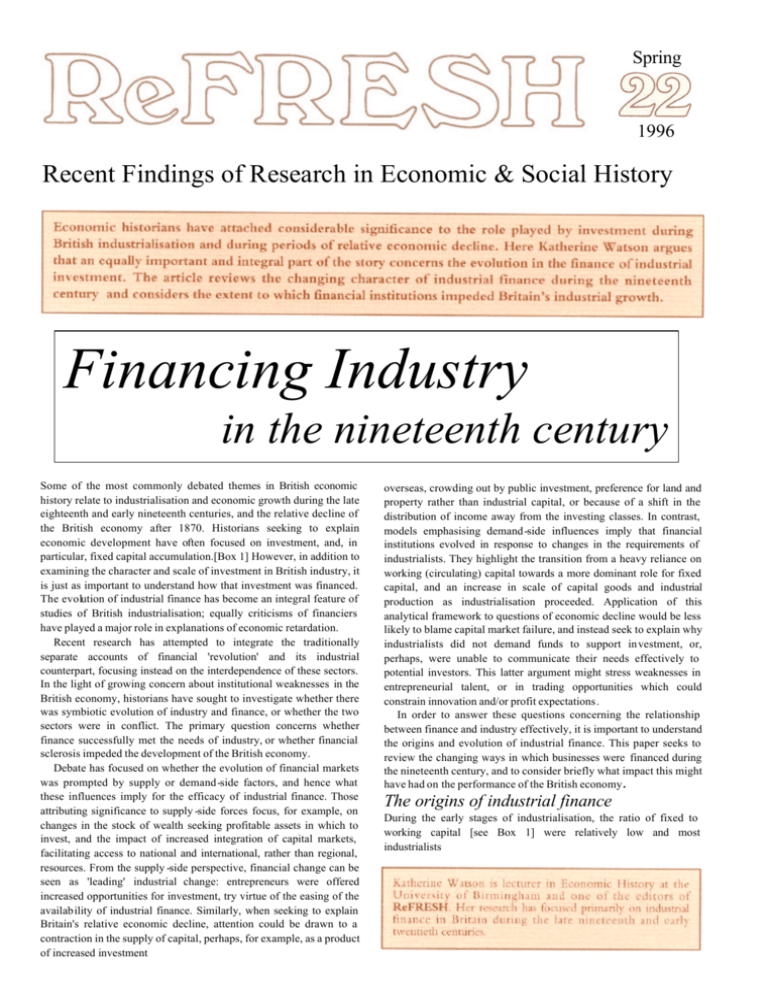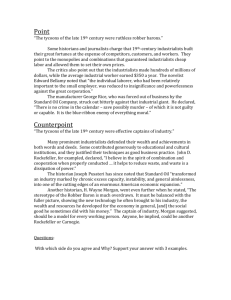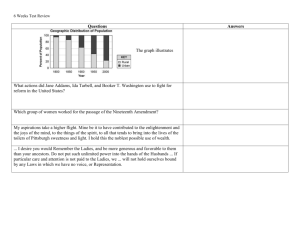Financing Industry in the 19th century
advertisement

Spring
1996
Recent Findings of Research in Economic & Social History
Financing Industry
in the nineteenth century
Some of the most commonly debated themes in British economic
history relate to industrialisation and economic growth during the late
eighteenth and early nineteenth centuries, and the relative decline of
the British economy after 1870. Historians seeking to explain
economic development have often focused on investment, and, in
particular, fixed capital accumulation.[Box 1] However, in addition to
examining the character and scale of investment in British industry, it
is just as important to understand how that investment was financed.
The evolution of industrial finance has become an integral feature of
studies of British industrialisation; equally criticisms of financiers
have played a major role in explanations of economic retardation.
Recent research has attempted to integrate the traditionally
separate accounts of financial 'revolution' and its industrial
counterpart, focusing instead on the interdependence of these sectors.
In the light of growing concern about institutional weaknesses in the
British economy, historians have sought to investigate whether there
was symbiotic evolution of industry and finance, or whether the two
sectors were in conflict. The primary question concerns whether
finance successfully met the needs of industry, or whether financial
sclerosis impeded the development of the British economy.
Debate has focused on whether the evolution of financial markets
was prompted by supply or demand-side factors, and hence what
these influences imply for the efficacy of industrial finance. Those
attributing significance to supply -side forces focus, for example, on
changes in the stock of wealth seeking profitable assets in which to
invest, and the impact of increased integration of capital markets,
facilitating access to national and international, rather than regional,
resources. From the supply -side perspective, financial change can be
seen as 'leading' industrial change: entrepreneurs were offered
increased opportunities for investment, try virtue of the easing of the
availability of industrial finance. Similarly, when seeking to explain
Britain's relative economic decline, attention could be drawn to a
contraction in the supply of capital, perhaps, for example, as a product
of increased investment
overseas, crowding out by public investment, preference for land and
property rather than industrial capital, or because of a shift in the
distribution of income away from the investing classes. In contrast,
models emphasising demand-side influences imply that financial
institutions evolved in response to changes in the requirements of
industrialists. They highlight the transition from a heavy reliance on
working (circulating) capital towards a more dominant role for fixed
capital, and an increase in scale of capital goods and industrial
production as industrialisation proceeded. Application of this
analytical framework to questions of economic decline would be less
likely to blame capital market failure, and instead seek to explain why
industrialists did not demand funds to support investment, or,
perhaps, were unable to communicate their needs effectively to
potential investors. This latter argument might stress weaknesses in
entrepreneurial talent, or in trading opportunities which could
constrain innovation and/or profit expectations.
In order to answer these questions concerning the relationship
between finance and industry effectively, it is important to understand
the origins and evolution of industrial finance. This paper seeks to
review the changing ways in which businesses were financed during
the nineteenth century, and to consider briefly what impact this might
have had on the performance of the British economy.
The origins of industrial finance
During the early stages of industrialisation, the ratio of fixed to
working capital [see Box 1] were relatively low and most
industrialists
found their needs were met from the support of merchant capital. in
the earliest stages of proto-industrialisation [see Hudson in
ReFRESH 10] this took the form of the 'putting-out' system, in
which merchants would supply raw materials and tools (the working
capital) and collect articles for sale on completion. Hudson's work on
the wool textile industry of West Yorkshire describes the
development of a credit matrix tying together individuals or families
supplying goods for sale with those who effectively financed the
production process.[l]
During the late eighteenth and into the early nineteenth century, it
became more efficient for at least some production processes to be
co-ordinated under one roof, thereby easing the costs of distributing
raw materials to domestic manufacturers, facilitating control of the
work- force, and permitting economies of scale.[see Jenkins in
ReFRESH 16] As the scale of production increased, so too did the
demand for industrial capital. Initially investment was largely
financed informally from internal sources, including family, friends,
partnerships, and by ploughing back profits. However, there is also
evidence of a growing reliance on external supplies of capital.
Capital markets were essentially regional in the first instance,
drawing, for example, on the talents of local scriveners (money
lenders) and attorneys who would act as intermediaries between
borrowers and lenders overseeing mortgage contracts and transactions
of bills of exchange. After 1750 there was also an expansion in the
number of country banks.[see Capie in ReFRESH 16] These
provided an important service as interest-bearing repositories for local
savings, which could then be recycled to discount bills of exchange
and pro - vide short term loans. In some cases they were also able to
issue notes. Country banks thus served a valuable function as
intermediaries at a local level between creditors and borrowers, and
between regional interests and London. Interestingly, the relationship
between country banks and businesses was often very close, many
banks having been established by industrialists. Manufacturers
typically formed banks as a means of meeting their own needs by
being able to draw on deposits, but also to make profitable use of any
surplus income by offering it as loans. The brewing, textiles and
metals industries were particularly closely associated with the
development of banks, the pattern of their trade being most likely to
generate surplus loanable funds. [2]
The emergence of a national capital market
Financial historians have devoted considerable energy seeking to
identify the date by which an integrated national capital market can
be said
Watson, Refresh 22 (Spring 1996)
to have emerged in Britain. Hoppit has argued that by the end of the
eighteenth century, businesses were sufficiently reliant on trade credit
via, for example, bills of exchange [see Box 1], that the spheres of
public (government) finance (funded by the issue of debt (bonds)) and
private finance were integrated. To support his claim he draws on the
evidence available from bankruptcy statistics to demonstrate the rapid
transmission of financial crises into the real economy. [3] Supporting
evidence has also come from Buchinsky and Polak, who suggest that
there was a strong association between fluctuations in long term
interest rates in London and property transactions in Middlesex and
West Yorkshire by the end of the eighteenth century. [4]
This evidence of integration is important. Although the consensus
view still accepts Hudson's observation that much of the market for
industrial and commercial capital was regional before the 1830s and
1840s, and that the dominant suppliers of finance were still internal to
industry, it is clear that the financial network had extended across the
national economy by this period. Thus, although there were still
obvious imperfections in the capital market largely due to restrictions
on communications and information flow, there were nevertheless
opportunities for diversifying risk away from the immediate locality,
and channels for transmitting funds between regions. As Larry Neal has
argued recently, this meant that, far from being separate entities, the
financial and industrial 'revolutions' were closely intertwined from the
eighteenth century and, furthermore, that financial progress played a
vital role in providing the wherewithal for industrial expansion [5].
These arguments are still subject to debate and revision. Joel Mokyr
has recently accepted Neal's view that the traditional separation of
financial and industrial revolution was an over-simplification, but he
still contends that the level of support which finance offered industry
was limited. Even if some firms gained from integration of the capital
markets, he suggests that there were many who were likely to have
been constrained by their dependence on predominantly regional
sources of funds. Mokyr concludes that had the imperfections in
Britain's capital market been resolved earlier, the industrial revolution
might have occurred sooner: far too frequently, fixed capital had to
grow by 'pulling itself up by its bootstraps'. [6] Notwithstanding the
significant progress made with recent research, it seems clear that there
is much left for economic historians to do if this debate is to be
resolved.
This recent research (and especially the work of Neal) seems to be
more sympathetic to the supply-side argument that finance led industry
in its development. However, it is crucial not to lose sight of the
demand-side influences. The fact that many of the emerging financial
institutions originated in industry, suggests that changes in the demand
for capital played a significant role in determining the character of
industrial finance. It seems clear that attempts to classify the
development of industrial finance should not rely too heavily on
supply - or demand-side influences alone. Taking account of this
interdependence of factors becomes even more important when
considering the increasing sophistication of the capital market after
1830.
The evolution of industrial finance
after 1830
By the mid-nineteenth century partnerships and firms under sole
ownership still constituted the principal form of business
organisation. This reflected in part the legal restrictions and high cost
associated with the formation of joint stock companies following the
introduction of the 1720 Bubble Act, but was also due to
entrepreneurs continuing to resist dilution of personal contacts and
control. In the wake of the repeal of the Bubble Act in 1825, further
legal reforms began to make company formation more attractive. At
last, in 1856 the passage of the
two
Limited Liability Act finally saw firms able to form joint stock
companies which allowed the liability of partners to be limited to the
extent of their stake in the company, without having first to seek
parliamentary approval. Several subsequent amendments to this Act
were eventually consolidated in the Companies Act of 1862 which
extended the provisions of the 1856 Act to all companies, including
those in banking and insurance. This final relaxation of legal
restrictions paved the way for the wider adoption of corporate status in
business, with over 24,000 companies registered in the next twenty
five years . [7]
During this period there were also significant changes
in the opportunities available to companies seeking
finance. Supplementing the services provided by the
developing banking system, the new issue market and the
stock exchanges of London and the provinces began to
play an increasingly important role in industrial finance.
The development of the railways provided a major
stimulus to the expansion o f the capital market, both via
improvements in communication and integration of the
national economy, and via their direct influence on institutional developments. Although canals and utilities had
been quoted on the London stock exchange from the
early nineteenth century, railways provided the greatest
volume of securities aside from government debt. During
the 1830s and 1840s the railway 'mania' gathered pace.
The provinces benefited particularly from this increased
volume of trade. London had previously been dominated
by trade in foreign and government debt, leaving provin cial stockbrokers largely confined to trade in the securities
of canals and utilities. The attraction of railways in the
provinces was immense; the foundation of formal stock
markets in the provinces was a logical outcome of this
increased trade.[8] With stock exchanges established in
the principal regional industrial centres including
Manchester and Liverpool in 1836, and Leeds and
Birmingham in 1845, the potential for mobilising local
capital was increased. Improvements in transport and
communications via railways initially, and, later, the telegraph and telephone, facilitated information flow, reducing risk, and encouraging an expansion in capital supply.
Despite these changes in the availability of capital, the
development of external industrial finance was very slow,
primarily because of the reluctance of partners in what
were often family businesses to relinquish control to 'outside' investors. Wilson cites the example of Sebastian de
Ferranti, who, having earned an extensive reputation in
electrical engineering, rejected all advice to convert his firm into a
public limited company. He was convinced that if his control of the
business was diluted, he would lose all interest in it.[7] Similar
examples can be found in the brewing industry, where partners were
concerned not to impair family influence. [9]
Eventually, the demands of industrial innovation forced many
businesses to look beyond the immediate avenues of internal finance to
support investment. The scale of fixed capital requirements increased
during the latter half of the nineteenth century, placing many projects
beyond the reach of private investors. In addition, in sectors where
investment projects faced long gestation periods, industrialists often
preferred to share the burden of risk by floating capital for public
subscription.[10] From the 1860s onwards, increasing numbers of
industrial companies sought capital from the new issue market
beginning with iron and mining companies, cotton and shipping firms.
The relative success of many of these ventures inspired confidence
Watson, Refresh 22 (Spring 1996)
in lenders and borrowers alike, but it was not until the 1880s and the
home investment boom of the 1890s that public quotation of
industrial companies really accelerated, eventually enticing 'new
industries' such as electrical engineering, chemicals, cycles and
motor-vehicles to enter the market. By the late 1880s the trade in new
issues of converted limited liability companies was so buoyant that
some commentators began to urge wariness about the quality of the
issues on offer, fearing that scoundrels might seize the opportunity
offered by an
investment boom to float companies that were in effect worthless .[See
illustration]
Indicative of the growth in trade during this period was the growth
of the financial press seeking to reach a wider audience of potential
readers interested in the functioning of the markets. Although some
papers provided a vehicle for unscrupulous company promoters to 'puff
their securities, journals such as the Investor's Monthly Manual,
Burdett's Official Intelligence and the Investors' Review provided a
wealth of commentary and advice on the issues of the day. These
developments in financial journalism had the effect of increasing
information flow and raising awareness of issues, thereby encouraging
the expansion of formalised external finance of industry.
It is important to consider the changing character of industrial
securities during this period, as well as noting the increased scale of
flotations and the ever broader range of industries making issues. The
pattern of industrial finance during this period provides valu able clues
three
as to the nature of the growing relationship between industrialists and
financial institutions. The experience of the brewing industry
provides a good example of the developing sophistication of
industrial finance during the late nineteenth century.
In 1886, Guinness converted to a public limited company, floating
capital worth an immense 46 million. Their issue was oversubscribed
many times, boosting confidence in the availability of capital, and
stimulating a rapid rise in the value of their shares. Other brewers
were attracted by the success of Guinness and by the opportunity to
raise
capital which would enable them to purchase licensed houses to
consolidate a trade which was becoming increasingly competitive.
Investors too were enticed by the apparent security of brewing shares
which seemed only to rise in value. Given the abundance of public
support for brewing flotations, brewers were able to side-step the
problem of compromising control of the business when seeking
external capital. In many cases the original partners and directors of
the family firm retained the equity capital in the business, issuing
only preference and debenture capital.[see Box 2] In this way, too, in
periods when profits were expected to rise, companies would only be
liable for relatively low fixed interest payments, releasing a larger
share of profits for distribution amongst the holders of equity capital
or for reinvestment in the company.
This strategy of issuing relatively high proportions of capital as
debentures rather than equity ('high gearing') had been made possible
by the increased diversity in the characteristics and denomination of
shares offered for trade. During the 1880s there had been a move
towards shares being issued in much smaller denominations.
Arguments raged about the advisability of these arrangements, fearing
that if investors held only a small stake in a company, their
commitment would be reduced and speculation might be encouraged.
However, the advantage of issuing shares of lo wer value was that
more investors could afford to participate in the market for industrial
securities. Similarly the development of preference shares, which
entitled holders to priority payment of a guaranteed dividend, helped
to tackle perceived problems of risk aversion amongst investors. By
designing this range of securities, industrialists were better able to
take advantage of the opportunities available in the new issue market
for supporting fixed capital accumulation.
Capital market failure?
Despite the transformation in financial institutions during the
nineteenth century, most industrial investment continued to be
financed from internal resources, with some firms making occasional
incursions into the new issue market, and others relying on banks and
institutions such as insurance companies to supply essentially short
term loans. As late as 1914, approximately 75 per cent of the limited
Watson,
liability companies
Refresh 22 (Spring 1996)
registered were private rather than public concerns, meaning that they
could not trade shares publicly via the stock exchanges.
A long-running debate in economic history has focused on the
extent to which this relatively limited use of these new opportunities
by industrialists reflected capital market (and also bank) failure.
Attention focused initially on the dramatic expansion of overseas
investment prior to the first world war and the belief that British
industry may have been starved of funds by biased investors. The
work of Michael Edelstein [11] has largely exonerated investors from
blame, but the debate has now shifted to suggest that institutional
imperfections restricted the flow of information within the domestic
market, impeding the supply and efficient allocation of industrial
investment.[12] This view has been challenged strongly by Michie,
who focuses instead on the factors influencing changes in the demand
for industrial investment, emphasising, in particular, legal restrictions
which constrain ed the implementation of innovations. [10]
The evidence presented here suggests that the nineteenth century
saw a dramatic transformation in the potential sources of industrial
finance, and a significant increase in the flexibility of approaches
adopted, even if most business largely remained wedded to their
traditional ways. Much of this transformation was prompted by the
changing demands of industrialists. To this extent, it seems essential
that finance should remain an integral feature of studies of industrial
performance. Furthermore, given the extent and character of this
transformation, it seems unreasonable to regard financial institutions
as impeding industrial development. While supply -side factors should
not be ignored, this paper is sympathetic to those who stress the
importance of demand-side influences.
References
[1] P. Hudson, The Genesis of Industrial Capital, A Study of the West
Riding Wool Textile Industry c. 1 750- 1850 (1986).
[2] P.L. Cottrell, Industrial Finance, 1830-1914 (1979).
[3] J. Hoppit, 'Financial Crises in Eighteenth-Century England',
Economic History Review, XX-XIX, 1, (I 986).
[4] M. Buchinsky & B. Polak, 'The Emergence of a National Capital
Market in England, 1710-1880', Journal of Economic History, 53,
1, (1993).
[5] L. Neal, 'The finance of business during the industrial revolution', in P,. Floud & D.N. McCloskey (eds.), The Economic
History of Britain Since 1700, volume 1: 1700-1860 (2nd
edn.,1994).
[6] J. Mokyr, The British Industrial Revolution, An Economic
Perspective (1993).
[7] J. Wilson, British Business History, 1720-1994
(1995).
[8] M.C. Reed, Investment in Railways in Britain, 18201844 (1975).
[9] K. Watson, 'The New Issue Market as a Source of Finance for
the U.K. Brewing and Iron and Steel Industries, 1870-1913', in Y.
Cassis, G. Feldman & U. Olsson (eds.), Financial Institutions and
Financial Markets in Twentieth Century Western Europe and
North America (1995).
[10] R.C. Michie, 'The Finance of Innovation in Late Victorian and
Edwardian Britain', The Journal of European Economic History,
17, 3, (1988).
[11] M. Edelstein, Overseas Investment in the Age of High
Imperialism (1982).
[12] See, for example, W. Kennedy, Industrial Structure, Capital
Markets and the Origins of British Economic Decline (1987).
four









